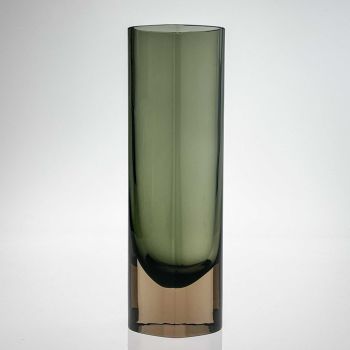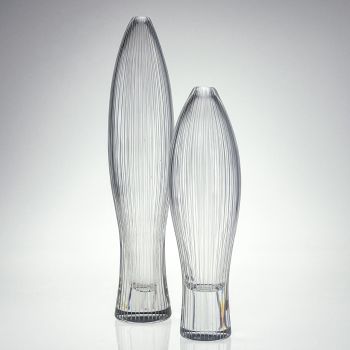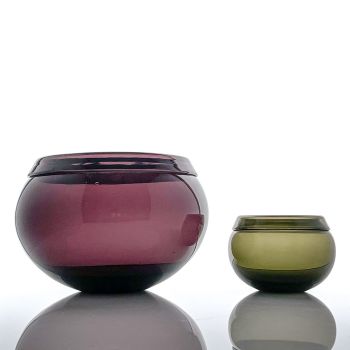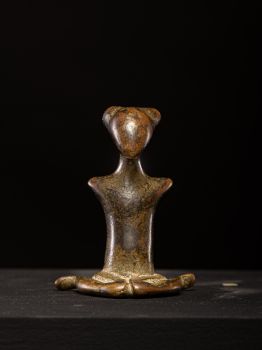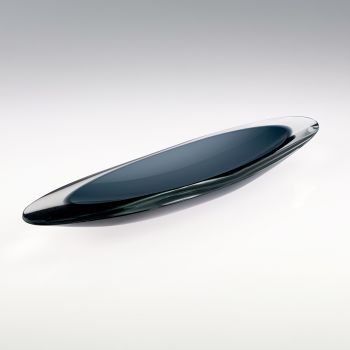A multicoloured enameled copper bowl – 1960’s or 1970’s 1960 - 1979
Saara Hopea
MetalCobre vermelhoEsmalte
4 cm, ø 14 cm
ConditionVery good
€ 575
Van Kerkhoff Art
- Sobre arteA multicoloured enameled copper bowl, with spot textured areas. Handmade by Saara Hopea in her own workshop in the 1960’s or 1970’s. The plate is signed on the reverse by the artist in diamondpen: Saara.
Saara Hopea started making these copper enameled plates in 1960 when she lived in New York City. The enameling on copper she learned from her husband Oppi Untracht who taught enameling at the Brooklyn Museum Art school. In a very short time she mastered this craft and in the early 1960’s several of her plates were bought by the Museum of Modern Art. The copper plates Saara Hopea used were hand lathe spun by Abram Bender in New York.
Saara’s enamel work was interupted between 1963 and 1967 when she lived in India and Nepal. When she moved back to Finland she established a new workshop in Porvoo. She kept making these enameled plates by hand until 1980.
About Saara Hopea
Saara Elisabet Hopea (Porvoo 1925 – Porvoo 1984), a prominent Finnish designer renowned for her innovative creations in art-glass, furniture, and jewelry, left an indelible mark on the world of design during her lifetime. Born in 1925 in the scenic town of Porvoo, situated in the southern region of Finland, Hopea’s artistic prowess and unwavering dedication to her craft propelled her to international recognition.
The daughter of Ossian Hopea and Lempi Westerlund, who owned a reputable goldsmithing company, Hopea was exposed to the world of design from an early age. After completing her secondary education, she honed her skills at the Interior Design Department of the Central School of Art and Design, now known as the esteemed Aalto University of Art and Design.
In 1946, Hopea proudly graduated, armed with a wealth of knowledge and a burning passion for design. She embarked on her professional journey as an illustrator before joining the lighting factory of Taito Oy, a renowned establishment under the guidance of celebrated designer Paavo Tynell.
However, it was in the early 1950s that Saara Hopea found her true calling when she delved into the realm of glass design. With an innate talent and an insatiable curiosity, she joined the Nuutajärvi glass factory, where she had the privilege of working alongside the esteemed artistic director, Kaj Franck.
In 1959, tragedy struck as Hopea’s father passed away, and she courageously took the helm of the family business, Ossian Hopea Oy. As the artistic director from 1959 to 1960 and later from 1967, she left an indelible mark on the company’s direction and was responsible for numerous iconic jewelry designs.
Her creative journey took an unexpected turn in 1960 when she married Oppi Untracht, an accomplished American goldsmith, photographer, and writer. Together, they embarked on an adventurous life that led them to reside in New York City, Nepal, and India, before eventually settling in Porvoo in 1967.
Hopea’s exceptional designs earned her widespread acclaim and accolades. Her glass creations were honored with silver medals at the esteemed Milan Triennials in both 1954 and 1957, showcasing her mastery of the craft on an international stage. She also received notable recognition closer to home, including the prestigious Porvoo City Culture Prize in 1981 and the State Arts and Crafts Prize in 1982.
Today, Saara Hopea’s impact resonates globally, with her works showcased in renowned institutions. The British Museum in London boasts an impressive collection of 28 of her pieces, while the Museum of Modern Art (MoMA) in New York proudly displays 11 of her distinctive creations.
Although she left this world in 1984, Hopea’s artistic legacy continues to inspire and captivate design enthusiasts. Her retrospective exhibition at the Museum of Arts and Crafts in Helsinki in 1987 served as a testament to her enduring influence, ensuring her innovative designs remain cherished and celebrated for generations to come.
Marked
Marked in diamondpen underneath the base: Saara
Execution
Made in her own workshop: 1960-1963; 1967-1979
Condition
This plate is in very good vintage condition. No chips, no dents.
Literature
Oppi Untracht – Saara Hopea-Untracht: her life and work. P. 202-213
Dimensions
Height 4,7 cm
Diameter 14,7 cm
Weight 265 grams - Sobre artista
Saara Hopea teve uma carreira prolífica em vários campos do design, deixando uma marca significativa na paisagem artística finlandesa da década de 1950. Sua jornada começou no mundo do design de móveis, onde aprimorou suas habilidades de 1946 a 1948. Em busca de novas oportunidades, juntou forças com a empresa do renomado serralheiro Paavo Tynell, onde trabalhou até 1952.
Durante esse tempo, ela contribuiu para a vidraria Nuutajärvi, onde suas criações se tornaram uma brilhante personificação da estética minimalista que definiu o estilo finlandês na década de 1950, influenciada pelos princípios da filosofia de design Bauhaus. Notavelmente, após a morte de seu pai em 1948, ela assumiu a tarefa de projetar talheres para sua loja em Porvoo.
Uma virada na vida de Hopea ocorreu quando ela se casou e se mudou para Nova York com o marido. Foi aqui que iniciou um novo percurso artístico, explorando o universo do trabalho com esmalte. Através de sua experimentação com esmaltes transparentes sobre queima sobre cobre, ela alcançou resultados notáveis que conferiram às suas peças uma aparência espontânea e pictórica, caracterizada por cores vibrantes e profundidade notável. Suas requintadas criações de esmalte chegaram às mãos de clientes exigentes por meio de lojas exclusivas.
A sede de conhecimento e inspiração artística do casal os levou a embarcar em uma viagem marcante pelo Nepal e Índia, ao longo de quatro anos. Durante esse tempo, eles mergulharam no estudo, fotografia e coleção de ourivesaria e joias locais. Em 1997, seu marido, profundamente influenciado por suas experiências, publicou "Joias Tradicionais da Índia", um testemunho de sua exploração e apreciação da rica herança artística da região. Em 1967, eles retornaram a Porvoo, onde os empreendimentos artísticos de Hopea abrangeram uma ampla gama de disciplinas, incluindo ourivesaria, design têxtil e esmaltação.
O impacto do talento e arte de Saara Hopea se estende além das fronteiras da Finlândia. O Museu Britânico possui uma coleção de 28 de suas obras, enquanto o Museu de Arte Moderna possui 11 itens preciosos, testemunho de seu legado duradouro. Em 1988, seu marido publicou um relato abrangente de sua vida e obra intitulado "Saara Hopea-Untracht: Life and Work", iluminando a notável jornada artística dessa tranquila visionária escandinava.
Você está interessado em comprar esta obra de arte?
Artwork details
Related artworks
- 1 - 3 / 3
- 1 - 4 / 24
Artista Desconhecido
Chinese gilt bronze censer, Xuande mark, 18th century, Qing dynasty18th century
Preço em pedidoMenken Works of Art
Artista Desconhecido
Dois Centauros, França ou Itálialate 18th
Preço em pedidoRobert Schreuder Antiquair
1 - 4 / 24Artista Desconhecido
A Japanese bronze Hu flower vase, Edo / Meiji, 19th century19th century
Preço em pedidoMenken Works of Art
1 - 4 / 24- 1 - 4 / 12
















